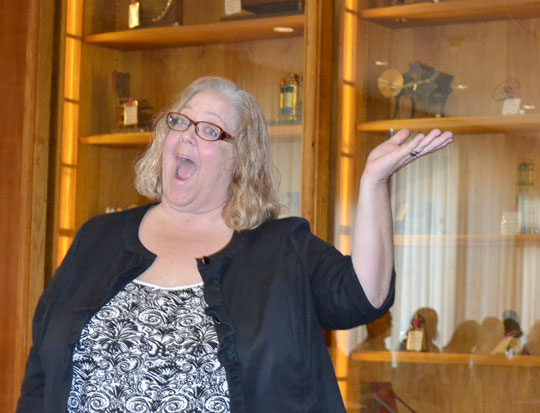Visitors to Longwood Gardens this summer increased by 51 percent when compared to last year. According to Paul Redman, Longwood’s director, good weather and the Munro light show contributed to the successful summer. Longwood Gardens admitted its one-millionth visitor last week.
Halsey Spruance, Director of Delaware Museum of Natural History, said that good weather isn’t necessarily good for an indoor venue when people want to be out of doors. Spruance reported that although attendance was slightly down this year, memberships were up.
Hagley Museum hosted a roundtable of member organizations of Brandywine Valley Museums and Gardens Alliance on Tuesday, Aug. 29. Directors of the 11 organizations reported stable or increasing attendance at their venues.
BMGA is a consortium of area attractions that “promotes the art, culture, history, and beauty of the Brandywine Valley.” Member organizations are Brandywine River Museum, Delaware Art Museum, Delaware Center for the Contemporary Arts, Delaware Historical Society, Delaware Museum of Natural History, Hagley Museum and Library, Longwood Gardens, Mt. Cuba Center, Nemours Mansion & Gardens, Rockwood Park & Museum, and Winterthur Museum, Garden & Library.
Betsy Price, feature editor of The News Journal, led a lively discussion among Alliance members beginning with “What will your venue look like in 50 years?”
Will these institutions disappear into cyberspace? Danielle Rice, director Delaware Art Museum, said that people use online access, but online information can fuel the need for social contact. Their “Clay Dates” give people a chance to get together at the museum. Rice sees Museums becoming more important as a place to get together.
Scott Loehr, Director Delaware Historical Society, said that is isn’t on anyone’s bucket list to visit a Web site but rather to visit the real site.
An online presence encourages participation of the audience. According to Maxine Garber, Director of Delaware Center for Contemporary Art, museums are not necessarily the “taste maker” anymore. People want input to the curatorial process. Garber noted while participation generates enthusiasm, it remains to be seen whether this will produce better exhibits in the long term.
The Nature Nook at Delaware Museum of Natural history encourages interaction between adults and children. Activities are designed for different aged children to participate in with their parents or care givers.
Price queried the group about their reaction to the “implosion” of the Delaware Symphony. She asked if the accounting practice of showing pledges as assets had impact on the way they ran their organization. Rice said that boards need to be independent and not assume data from management are flawless.
One of the most common measures of success in this group is the increased attendance. All groups reported stable or increasing attendance and increasing endowments both from investments and contributions. Other measures such as engagement, length of stay and loyalty were discussed.
School visits were down for all institutions even though they provide bus transportation for schools that ask for it.
Rice noted the demographic challenge of the baby boomers are a large part of their participants and donors. Numbers in this group are decreasing, and Delaware Art Museum is trying to attract a younger audience rather than try to increase the numbers from a decreasing population.
Does art create jobs? Garber reported that a recent study showed the arts collectively are the eighth largest employer in the State of Delaware.
Would the proposed National Park in Delaware benefit the cultural institutions? The directors saw no downside for creating a national park in Delaware. The park is proposed to be established by an 1,100 acre gift. Blain Phillips Jr., the Conservation Fund’s Mid-Atlantic director, was acknowledged for his vision and role as making the gift happen.
Virginia Logan, Director Brandywine Conservancy, said a park would result in 9,000 contiguous acres and 10 miles of protected riverfront. Some of the adjacent properties are under easement by the Brandywine Conservancy.
Whether the Brandywine Creek Park gets rolled into the proposed National Park is in discussion. The State of Delaware Park System is the fall back for the gift of land should a National Park initiative fail.
Directors were buoyed by the trends in admissions and in their endowments and with opportunities to enhance cultural life in the Brandywine Valley. All spoke of upcoming exhibits geared to attract yet more visitors. Price concluded the session with a personal request that Winterthur have a “Downton Abby” experience in the Henry Francis Dupont home.
Photo caption: Betsy Price leads a lively discussion. (Photo by Emily Myers)
About Emily Myers
Emily Myers has lived and worked in Chadds Ford for over thirty five years. She founded the parent company of Chadds Ford Live, Decision Design Research, Inc., in 1982. ChaddsFordLive.com represents the confluence of Myers' long time, deep involvement in technology and community. Myers was a founding member of the Chadds Ford Business Association and currently serves on its board of directors. Her hobbies include bridge, golf, photography and Tai Chi. She lives with her husband, Jim Lebedda, in Chadds Ford Township.
- Web |
- More Posts(96)


